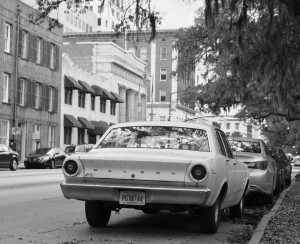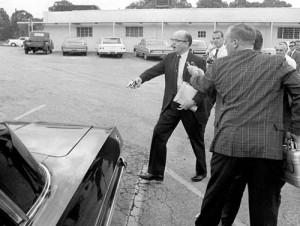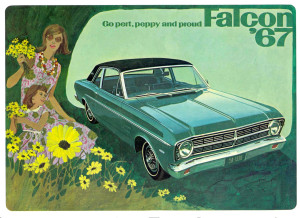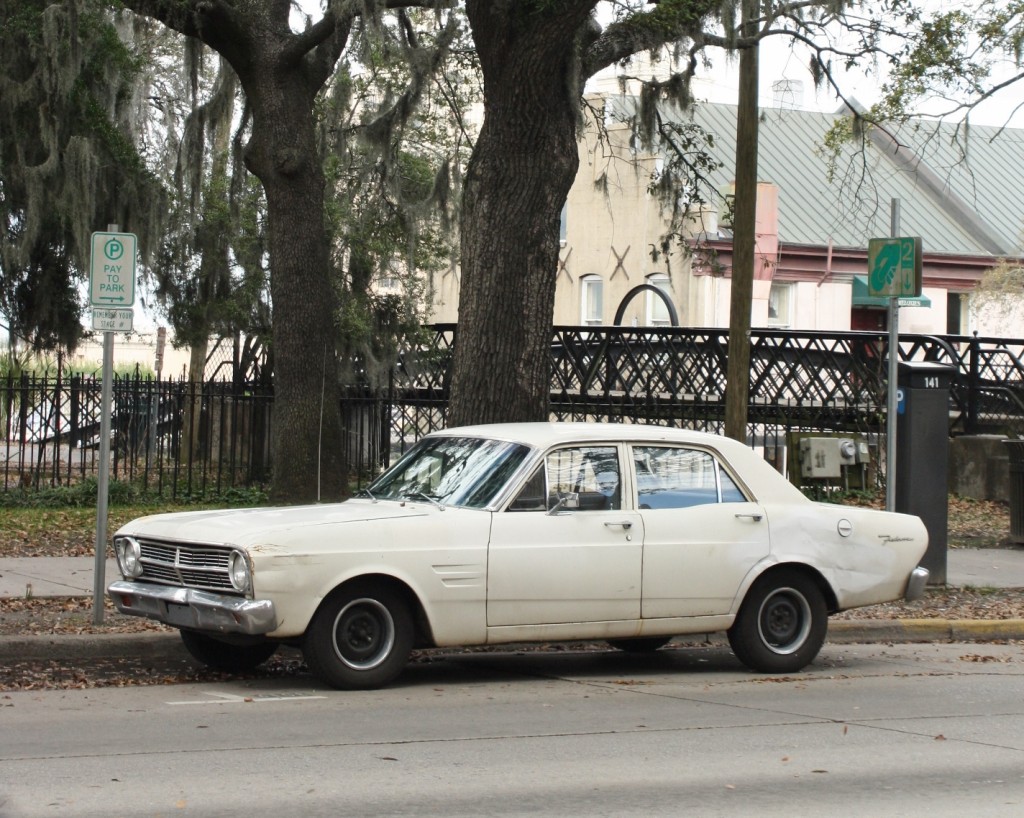
1967 Ford Falcon, spotted in Savannah, Georgia. 1960s beaters are nonexistent in Canada, but live on in the Deep South.
The great thing about temperate winters (besides not getting frostbite, slipping on ice, or having to pray for vehicle ignition on cold mornings) is the lack of salt.
Road salt is to cars the way Father Karras was to the demon inside Linda Blair. It destroys them, dissolves them, and sends them back to nature in their elemental state – in this case, iron oxide (rust).
Because of this, you rarely see any classic cars operating as daily drivers in northern climes. In the south, it’s a different story – if you’ve got the patience and the cash, your road-going classic can also be your grocery getter.
There’s also more to choose from, thanks to the preservation qualities of a warm, dry climate.
The ’67 Ford Falcon isn’t anyone’s idea of a ‘classic’, but it is a historic vehicle that saw many buyers back in the day. And this example, parked under hanging moss on the sultry streets of Savannah, sure has seen some use since the Summer of Love.
Dents and dings adorn the bumpers and body panels of this cream-coloured Falcon, with the rear fender displaying what is probably a do-it-yourself Bondo job.
It’s a beater, but unlike the rusty Civics and Cavaliers we see up in the Great White North, it’s got history and character backing it up. Think of the tumultuous events occurring in America in 1967 (few of them non-violent).
The deadly Detroit Riots took place that tension-filled summer, along with smaller riots in Buffalo, Minneapolis, Milwaukee and Washington, DC. The Vietnam War escalated amid a growing anti-war movement, while America’s space program recorded its first deaths – the three-man crew of Apollo 1 lost in a launch pad fire.
In Georgia, Democrat Lester Maddox – a staunch segregationist – took office as the state’s governor. Despite his controversial views, the state soon embarked on an economic development strategy that included the hiring of African-Americans to public positions, as well reforming the state’s health care, education and prison systems.
Culturally, 1967 saw an explosion of counterculture that steadily progressed over the next few years. Jimi Hendrix and The Doors released their debut albums, and overseas The Beatles released what many consider one of the most influential albums of all time – Sgt. Pepper’s Lonely Hearts Club Band.
It, like the rest of their material, was hit-and-miss.*
*Says this Stones fan
The Ford Falcon was not new, or all that exciting, in 1967. It was, however, competent and – as always – offered good value to the car buyer.
The simple, unibody Falcon was born in 1960 amid the ‘compact craze’ that afflicted the American auto industry following the dismal sales year of 1958 and the subsequent success of the Rambler American.
Oddly, the architect of the Falcon – Ford Motor Company ‘Whiz Kid’ Robert McNamara – was also the architect of the Vietnam War (he served as U.S. Secretary of Defence from 1961 to 1968).
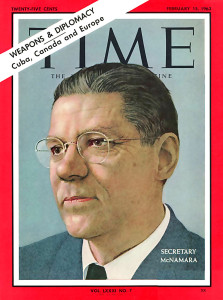
Former U.S. Secretary of Defence (and creator of the Ford Falcon) Robert McNamara on the cover of Time, 1963.
Designed to be roomy, easy to live with and easy on the pocketbook, the Falcon – though bland – outsold its competition handily. Powered by two economical and reliable straight-sixes (144 and 170 c.i.d.), it could be optioned with Ford’s smallest V-8 (260 c.i.d.) for more spirited performance.
The Falcon platform came in handy when then-exec Lee Iacocca was hunting for a cost-effective way to create an all-new sporty car to help shake up the company’s stodgy image. In 1964, the bones of the staid and sensible Falcon made way for the sexy and seductive Mustang.
The Falcon soon became available in a wide variety of body styles – sedan, coupe, convertible, and wagon – and served as the underpinnings of the Ranchero pickup.
More style and a longer list of engine options were on tap for 1964, in a bid to tap into the growing youth market. The third generation Falcon was introduced in 1966, this time based on a shortened Fairlane platform.
Signature round taillights continued to be used on the Falcon for ’66 and ’67, changing to a square setup from ’68 to the end of the model line in 1970.
Engine options for the third generation were many, ranging from the 144, 170 and 200 c.i.d. Thriftpower Six, to the 260, 289 and 302 c.i.d. Windsor V-8.
The Falcone name was retired from the American automotive landscape at the dawn of the 1970s, as Ford continued in the compact market with the Maverick and the Pinto. Overseas, the model name had longer legs – it continued in Argentina-built Fords until 1991, and is still in use in Australia.
An upmarket version of the Australian Falcon was sold from 1965 to 2008 under the equally familiar name Fairmont.
So, while this beater of a Georgia Falcon didn’t initially seem that significant, its history and the culture of its era say otherwise. For all we know, Lester Maddox or Jim Morrison once drove in it.
